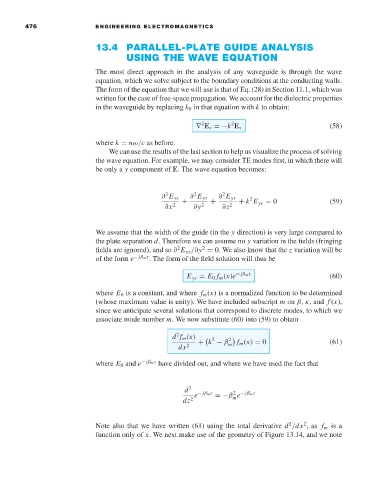Page 494 - Engineering Electromagnetics, 8th Edition
P. 494
476 ENGINEERING ELECTROMAGNETICS
13.4 PARALLEL-PLATE GUIDE ANALYSIS
USING THE WAVE EQUATION
The most direct approach in the analysis of any waveguide is through the wave
equation, which we solve subject to the boundary conditions at the conducting walls.
The form of the equation that we will use is that of Eq. (28) in Section 11.1, which was
written for the case of free-space propagation. We account for the dielectric properties
in the waveguide by replacing k 0 in that equation with k to obtain:
2 2
∇ E s =−k E s (58)
where k = nω/c as before.
We can use the results of the last section to help us visualize the process of solving
the wave equation. For example, we may consider TE modes first, in which there will
be only a y component of E. The wave equation becomes:
2 2 2
∂ E ys ∂ E ys ∂ E ys + k E ys = 0 (59)
2
∂x 2 + ∂y 2 + ∂z 2
We assume that the width of the guide (in the y direction) is very large compared to
the plate separation d. Therefore we can assume no y variation in the fields (fringing
2
2
fields are ignored), and so ∂ E ys /∂y = 0. We also know that the z variation will be
of the form e − jβ m z . The form of the field solution will thus be
E ys = E 0 f m (x)e − jβ m z (60)
where E 0 is a constant, and where f m (x)isa normalized function to be determined
(whose maximum value is unity). We have included subscript m on β, κ, and f (x),
since we anticipate several solutions that correspond to discrete modes, to which we
associate mode number m.Wenow substitute (60) into (59) to obtain
2
d f m (x)
2
+ k − β 2 f m (x) = 0 (61)
dx 2 m
where E 0 and e − jβ m z have divided out, and where we have used the fact that
d 2 − jβ m z 2 − jβ m z
m
dz 2 e =−β e
2
2
Note also that we have written (61) using the total derivative d /dx ,as f m is a
function only of x.Wenext make use of the geometry of Figure 13.14, and we note

